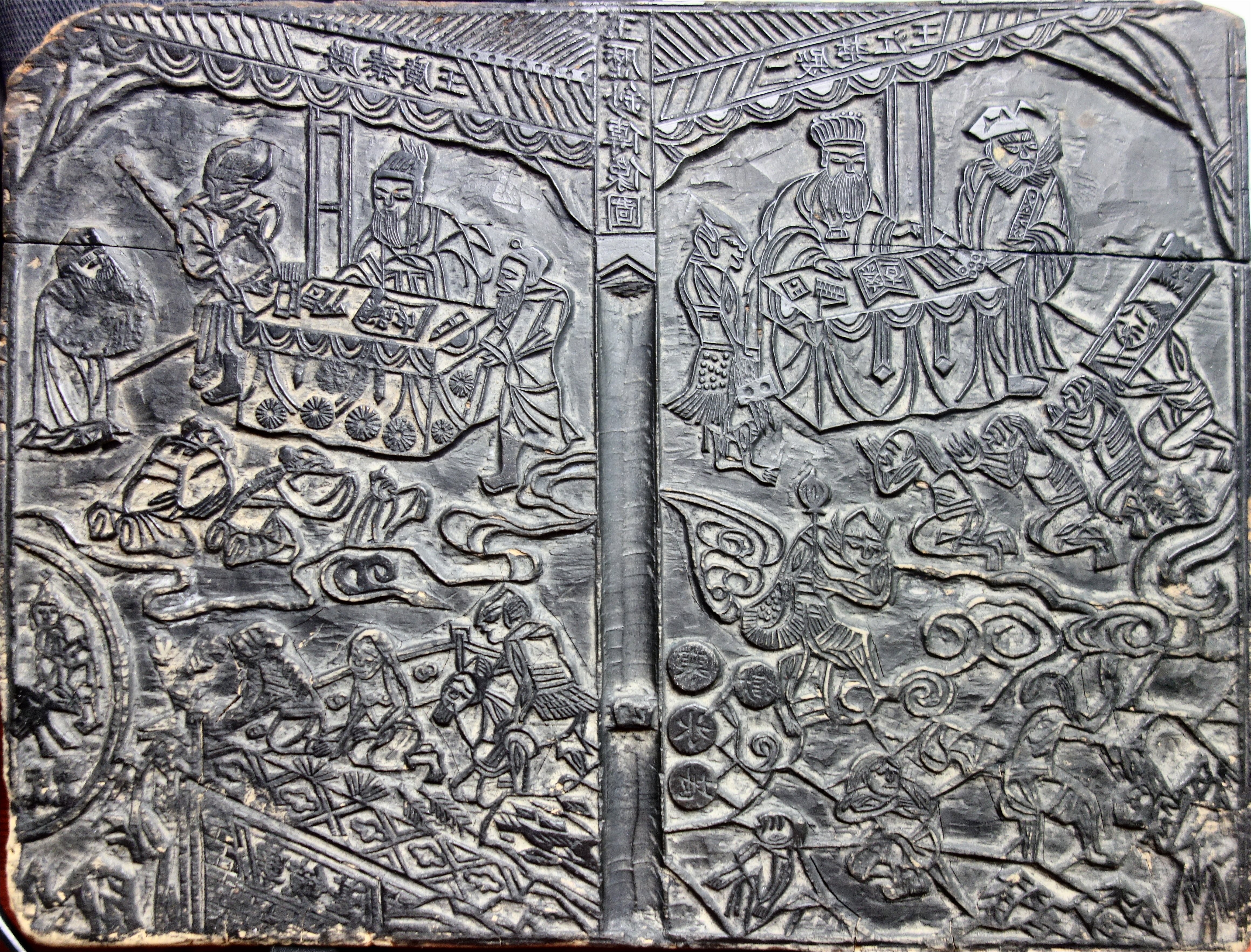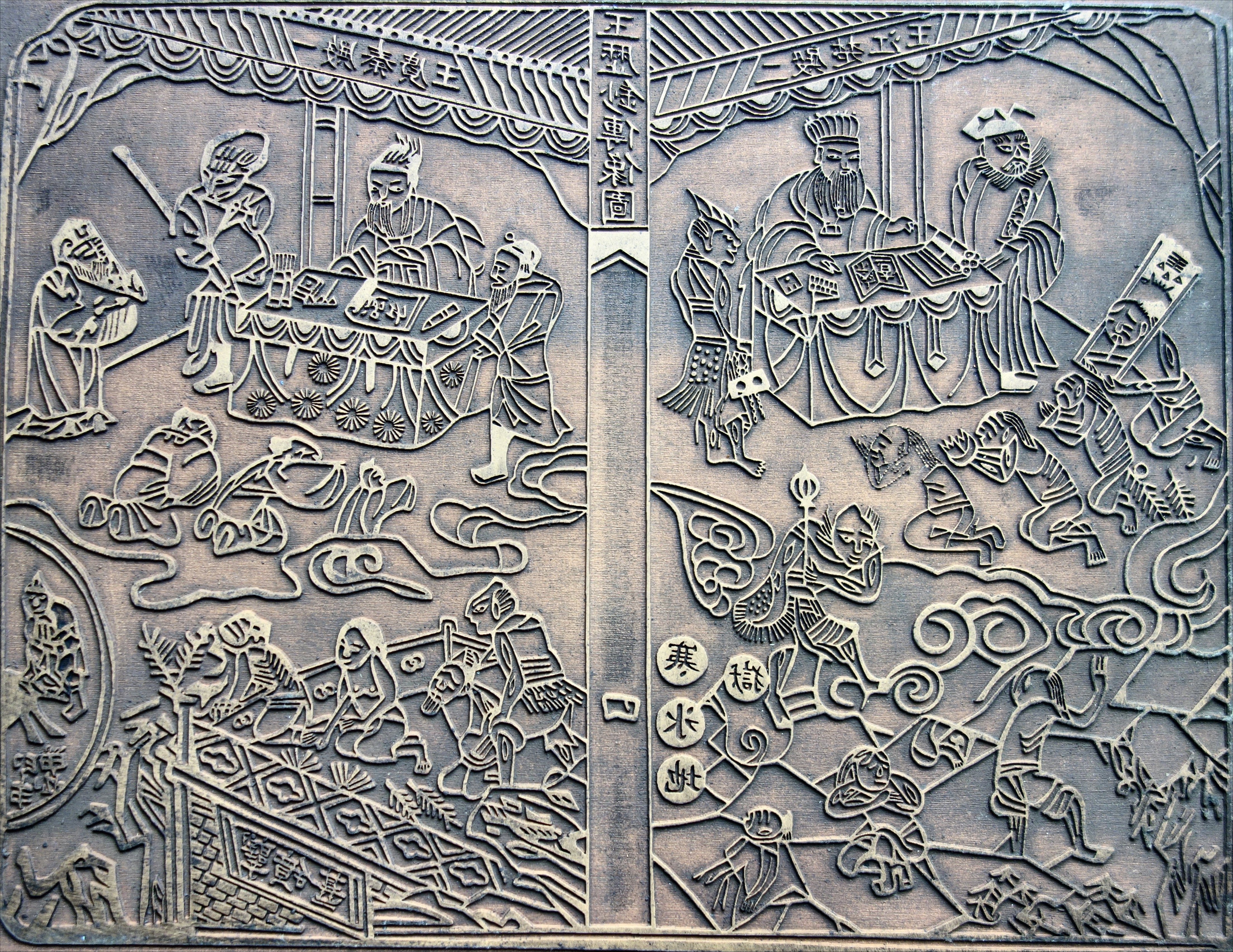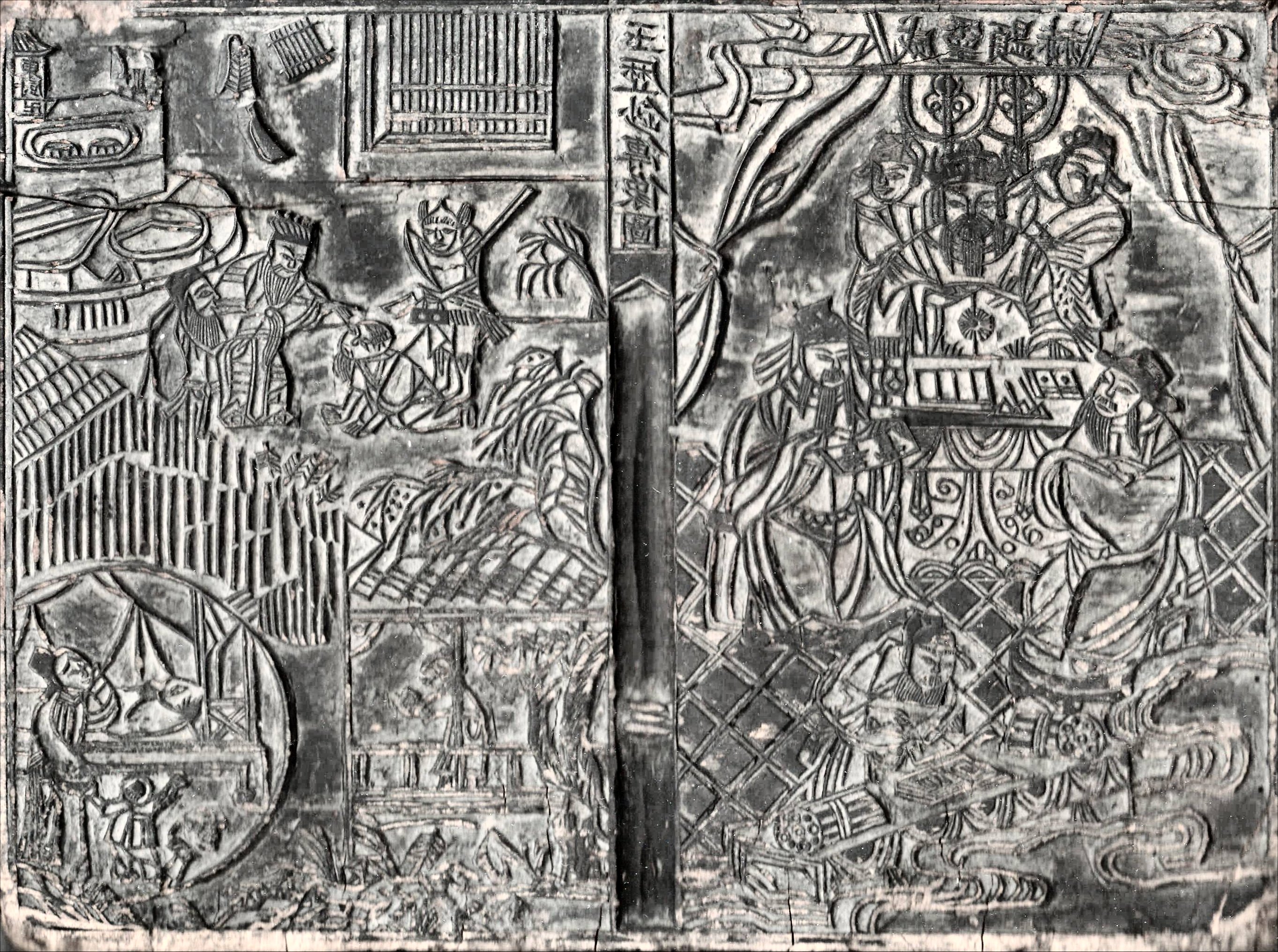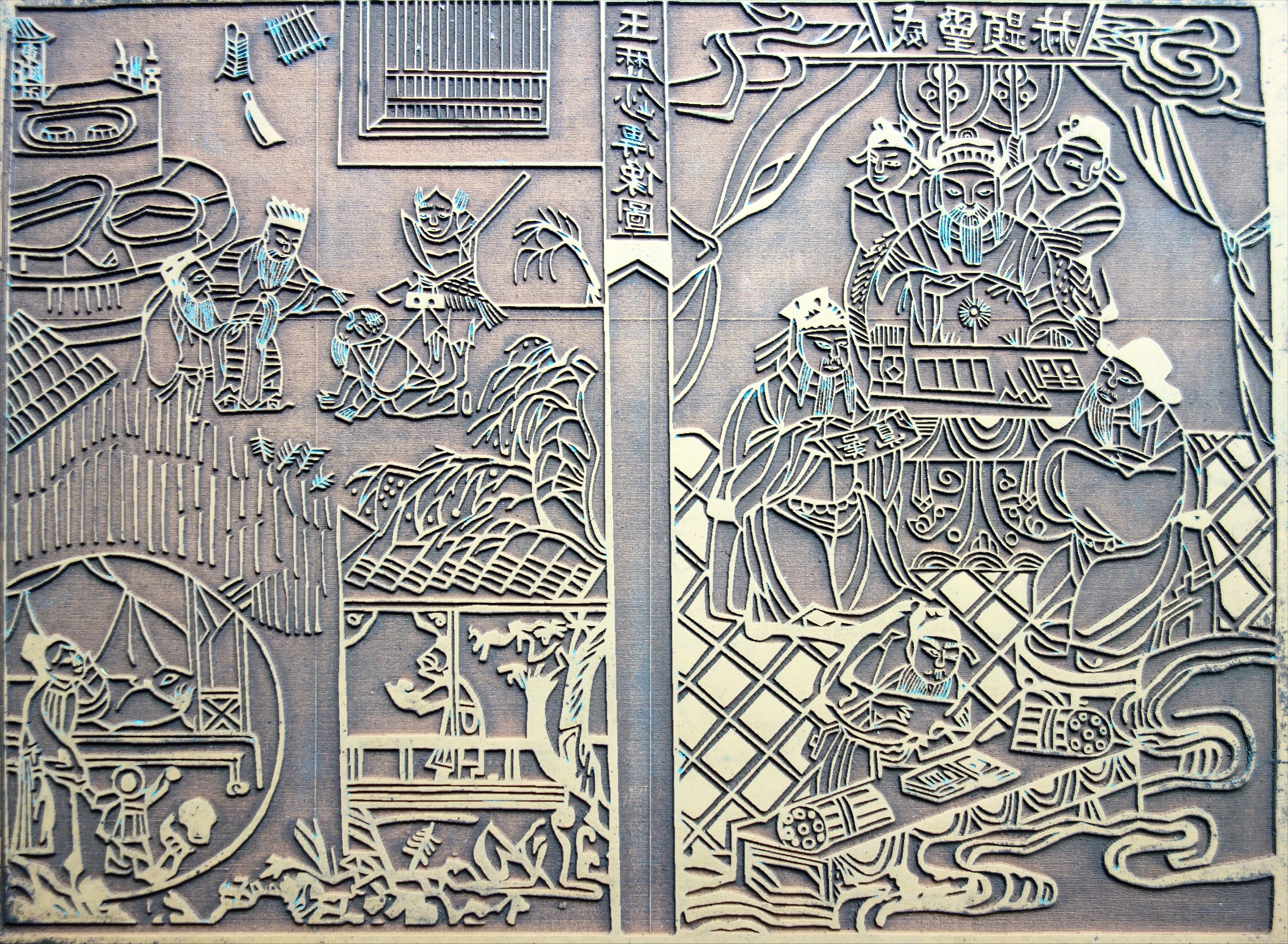 |  |
and to the right is a reproduction of it created by Computing & Information Services at Reed College. | |
 |  |
Illustrated woodblock for the Jade records II: From the reverse of the same woodblock,
| |
Jade records or Yuli 玉歴 are the textual equivalent to the late imperial hell scrolls, a literary genre that catalogues the tortures of each court. They project a spatial order onto hell with eight of the courts arranged in a tidy circle marking out the compass points – the entrance and exit hells being set apart in the far west and far east respectively – and each court includes sixteen sub-courts with specialized tortures. While this map is consistent, the various iterations of Jade records differ in other ways. Some versions append numerous historical anecdotes of damned individuals experiencing their earned torments; others add essays on moral behavior, efficacious deities and ritual guidelines. (None of the hell scroll sets I’ve seen appear to follow the Jade records layout and torture distribution.)
The Jade records provide their own origin story, a priest named Danchi 淡癡 personally visiting Fengdu in the 11th century to receive this text, then transmitting it to his disciple Wumi 勿迷 for the purpose of admonishing the world. Yet as far as I know, there are no surviving iterations that predate the early 19th century. For English translations of different Jade records iterations, see the work of George W. Clark, Léon Wieger, Herbert A. Giles and, much more recently, David K. Jordan. (The last can be found online here, and a Chinese transcription of an Yuli text can be found here.)
Printed via woodblocks, Jade records regularly include image sets that in most cases preface the text, and presented below are 187 images from eight Yuli (or Yuli-like) texts, all from the 19th century except for the last. Some of them have not survived in the best condition, subject to stains, tears and missing pages, but most images are clear. (Like all the hell scrolls on this site, the originals of these Yuli are in our private collection, but I have yet to comb through the texts themselves.)
 |  |
and to the right is a reproduction of it created by Computing & Information Services at Reed College. | |
 |  |
Illustrated woodblock for the Jade records II: From the reverse of the same woodblock,
| |
| An 1833 Shanghai recut from an 1807 text, Anshi deng 暗室燈 or Lamp for a darkened room is a collection of texts that begins with the standard Yuli picture program. Yet the Yuli text itself appears not to be present within this collection which is mostly devoted to anecdotes demonstrating proper relationships and behaviors. The deity Wenchang heavily figures in it. Like the 1874 Jade records below, this set devotes two images to each court, one of merits to be rewarded and the other of sins to be punished. | ||
Transcription and commentary of the Jade Records to admonish the world (1840) |
This 1840 iteration entitled Yuli chaozhuan jingshi 玉歴鈔傳警世 or Transcription and commentary of the Jade Records to admonish the world is in good condition, the text and pictures clear. According to the last image in this set, anyone interested in reprinting this text will find the woodblocks at a certain shop south of the Sanduo bridge in Suzhou. The photographed Yuli woodblocks above are closest to this set of images. | |
Transcription and commentary of the Jade Records to admonish the world (1855) |
Also entitled Transcription and commentary of the Jade Records to admonish the world, this iteration is in good condition although the cover is lost. It begins with a preface written at the “ancient Yang Tower monastery of Clearwater” 晴川之陽臺古刹. | |
Transcription and commentary of the Jade Records to admonish the world (1874) |
Like the 1833 Anshi deng above, this Transcription and commentary of the Jade Records to admonish the world devotes two images to each court, one of merits to be rewarded and the other of sins to be punished. According to the last image, the woodblocks can be found in Zhesheng 浙省 (Zhejiang?), but they were recut in the capital. Its prefaces also suggest it came from the Beijing area. |
|
Carrying out the true scripture for awakening the world: Evidence of spiritual efficacy (1881) |
Although not actually an example of the Jade records, this Fengxing jueshi zhenjing: Lingyan 奉行覺世真經: 靈驗 or Carrying out the true scripture for awakening the world: Evidence of spiritual efficacy includes several pictures of hell’s torments among its testimonials. The manuscript is not well preserved. | |
Transcription and commentary of the Jade Records to admonish the world (1883) |
This Transcription and commentary of the Jade Records to admonish the world is missing the cover and first few pages, although the prefaces suggest it came from the Beijing area. | |
| The “treasured raft” 寳筏 appended to the title of this Transcription and commentary of the Jade Records to admonish the world refers to the raft that transports sentient beings to their ultimate existence. The right side of this text’s title page advises the possessor to “Be careful not to dirty or damage this text nor thoughtlessly discard it. Otherwise your sins will be great, making you filthy and vile and causing you to meet with illness.” The left side states, “The woodblocks are in Yongcheng 永城 [Henan], in the Zhou family shop at the Ministerial Temple on Gate Monastery Street. Anyone wishing to print and distribute copies should personally supply paper and ink.” | ||
Transcription of the Jade Record’s greatest treasure to advise the world (1920) |
The last image of this Yuli zhibao chao quanshi玉歴至寶鈔勸世 or Transcription of the Jade Record’s greatest treasure to advise the world self-referentially shows its own publication and distribution in Shanghai from the Grand Office for Books on Goodness 宏大善書局. |